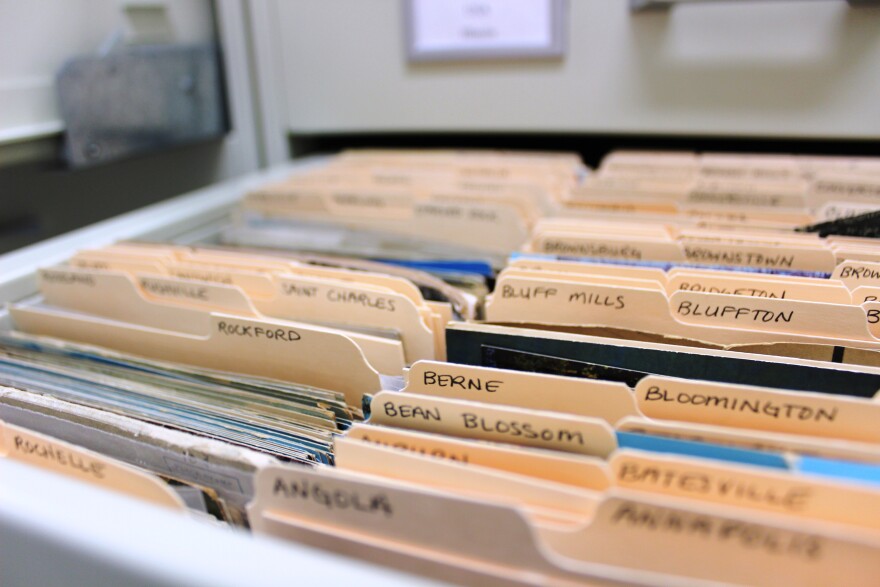Long before texting, Twitter, and Instagram, the best way to get a short message to a friend or loved one was to send a postcard. They could be found almost everywhere and people delighted in mailing pictures from their travels, or simply collecting them for fun. Miami University has hundreds of thousands of postcards and is now giving them a new life.
Marcus Ladd stands before a long row of old microfilm cabinets, opening drawer after drawer to reveal thousands of postcards. The Special Collections Digital Librarian says in total, Miami has more than half a million.

"People grossly underestimate the size of the collection," says Ladd. "Half a million postcards is just a mind-bogglingly large number of any sort of objects to have to manage and keep track of."
The Bowden Postcard Collection represents two lifetimes of collecting by Clyde Bowden and his friend Charles Shields. Shields donated his collection in 1986, Bowden in 2001. As a child, Bowden loved picking up cards during family trips from Hamilton to Florida, making the family stop in every tiny town in between.

"I was so anxious to stop and collect postcards along the way," says Bowden. "I guess it kind of got my grandmother a little upset. She said 'I didn't understand why he wanted to stop and get all these postcards.'"
What was it about the cards that he found so intriguing?
"Apparently because I'm interested in geography," he says.
He was also fascinated by architecture and historic preservation.
Postcards were first introduced in the late 1800s, says David Van Allen with the U.S. Postal Service, despite the wishes of a rather prominent Ohioan.
"Our federal government was afraid, at least some members of it were afraid, that being able to read a card with a message on the back… maybe someone would put a libelous message back there and it'd be 'a vehicle of great injury to the person to whom it was addressed.' And the person that actually said that was James Garfield when he was still a representative from Ohio, before he became president. However, that was resolved and people decided they wanted them."
Van Allen adds, "The years 1905 through 1915 are considered the post card craze."
He says in 1926 the post office processed 1.5 billion cards (postcards and postal cards). The number is more than double that today thanks to people trying to sell you windows or remind you to get your teeth cleaned.

Despite the vastness of Miami's collection, the cards weren't getting much use. So the library decided to bring the 20th century into the 21st. Ladd began meticulously cataloging and digitizing each card in 2013. He's created an online map pinpointing the exact location of the image on a card and all the metadata that goes with it... the printer, the publisher, if it was sent, to whom, what it says, and so on. The program makes it easier for people to use the collection and for the library to know what it has.
Ladd says the digital collection quickly became one of the university's most popular with people doing online searches and professors using them in lectures.
"In the collection itself we have about a hundred years of American pop culture history, international pop culture history actually. I mean, that's just a tremendous resource as far as popular culture goes. Plus what people are actually talking to each other about."
The messages are what student worker Jessica Scott likes best about the 2-and-a-half years she's spent cataloging the cards.
"(I) just like reading all the postcards, getting to see how it was back then. They wrote totally different too, so that was really cool just to see that," she says.

Adds Ladd, "We actually have some very interesting ones that Americans were sending back to other Americans from Germany in the mid-1930s. On one it is very much like, 'things aren't looking good here.' He's just writing to his friend or his brother, it's not really clear but some guy's just writing home on a postcard and he's like, 'Yeah, in Germany things are getting pretty weird here.'"
There are all kinds of postcards in the collection; some are even made of unconventional materials like wood or metal. They come from around the globe and include landmarks, photography, flora, fauna and fashion.
Ladd reaches randomly into the fashion drawer and comes out with a surprising handful of cards depicting scantily clad women on beaches.
"This was a big fashion, doing things… well… great choice, great choice." He pulls out one bikini clad pin-up card after another. Laughing, he says, "So we have dream girls and pin-up girls here and… it's exactly what you would expect."

Ladd's team has cataloged nearly 12,000 postcards so far with more expected to come online in the fall.



